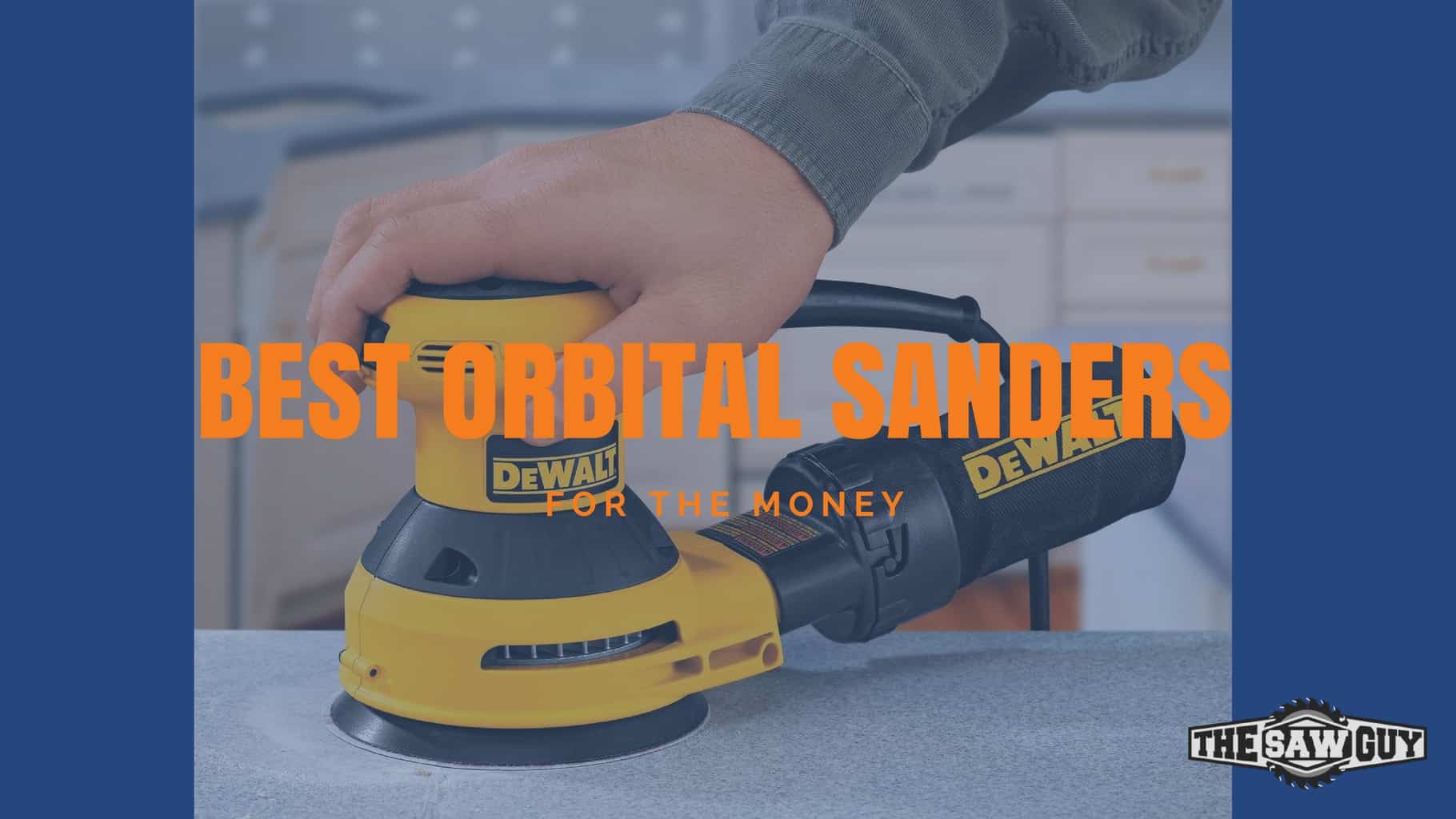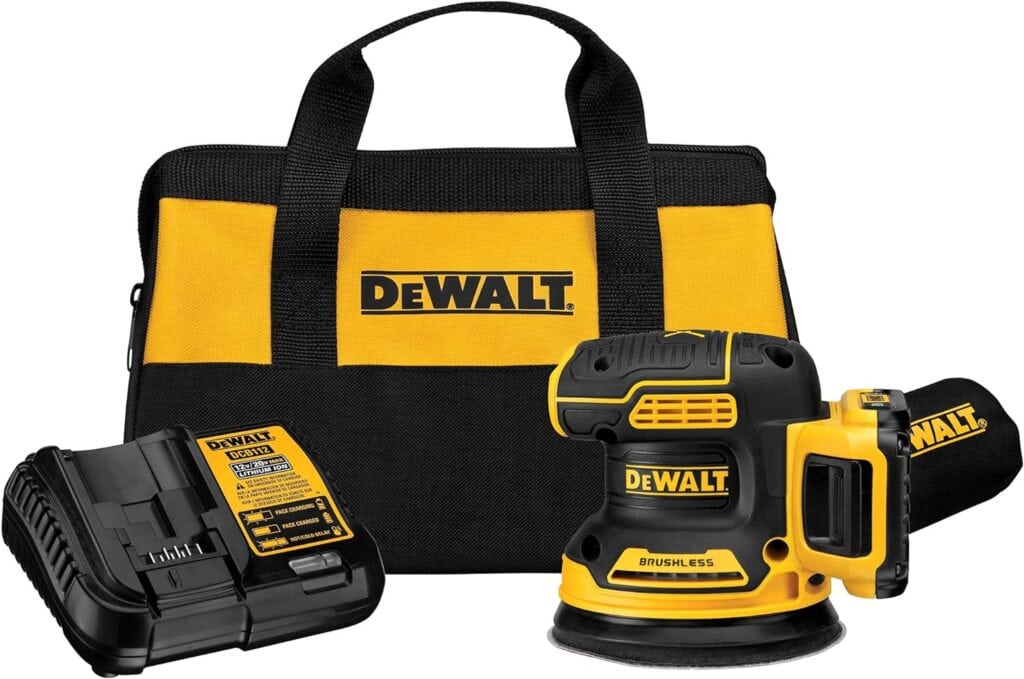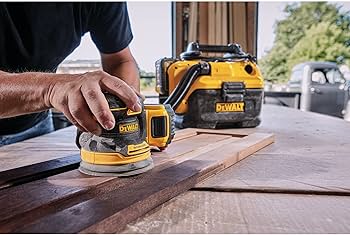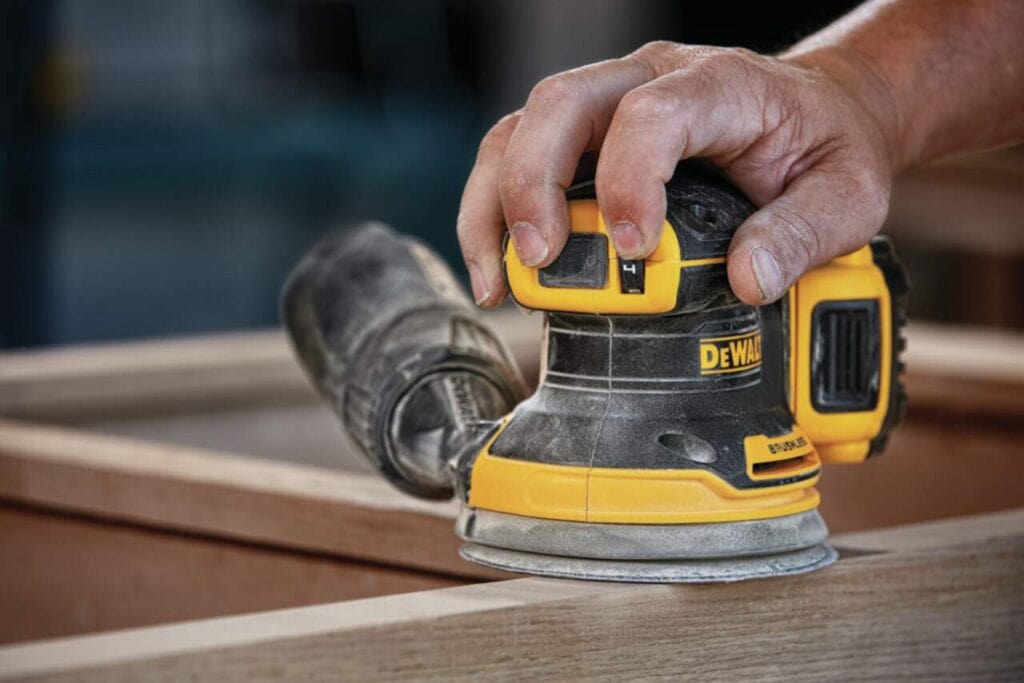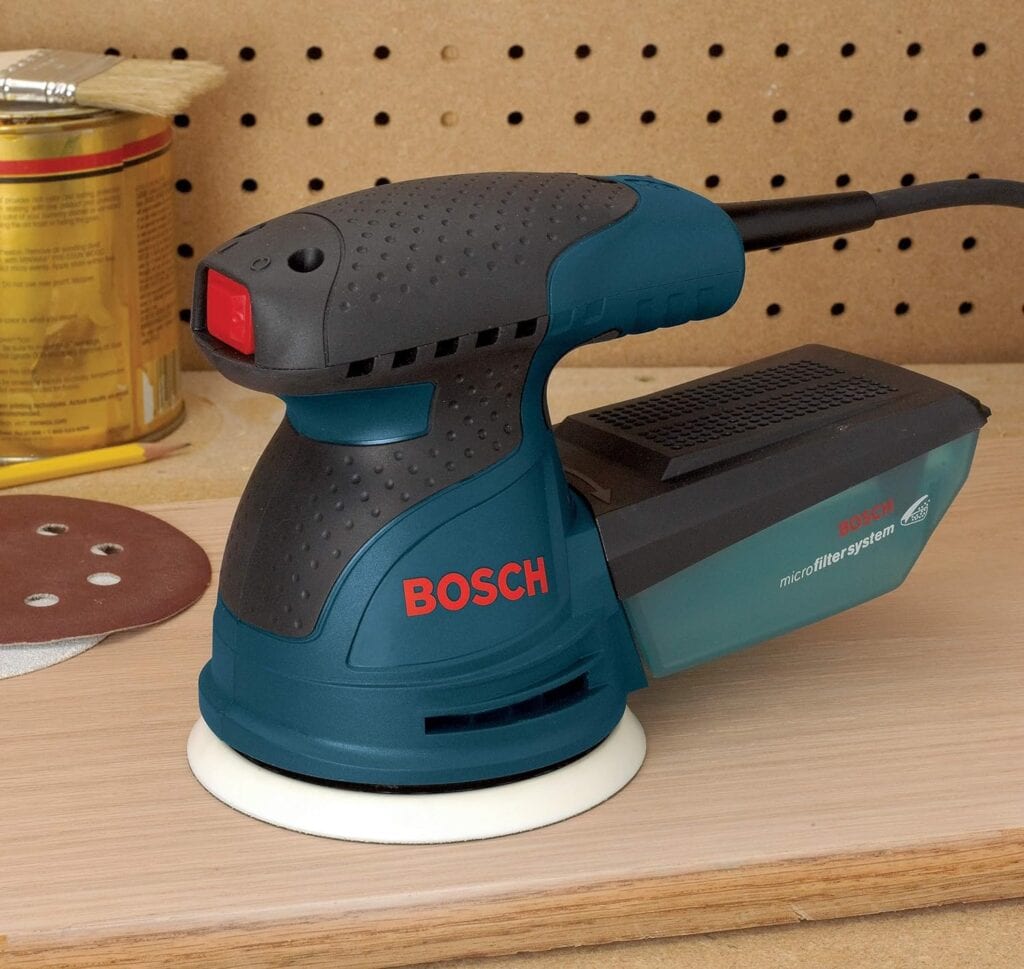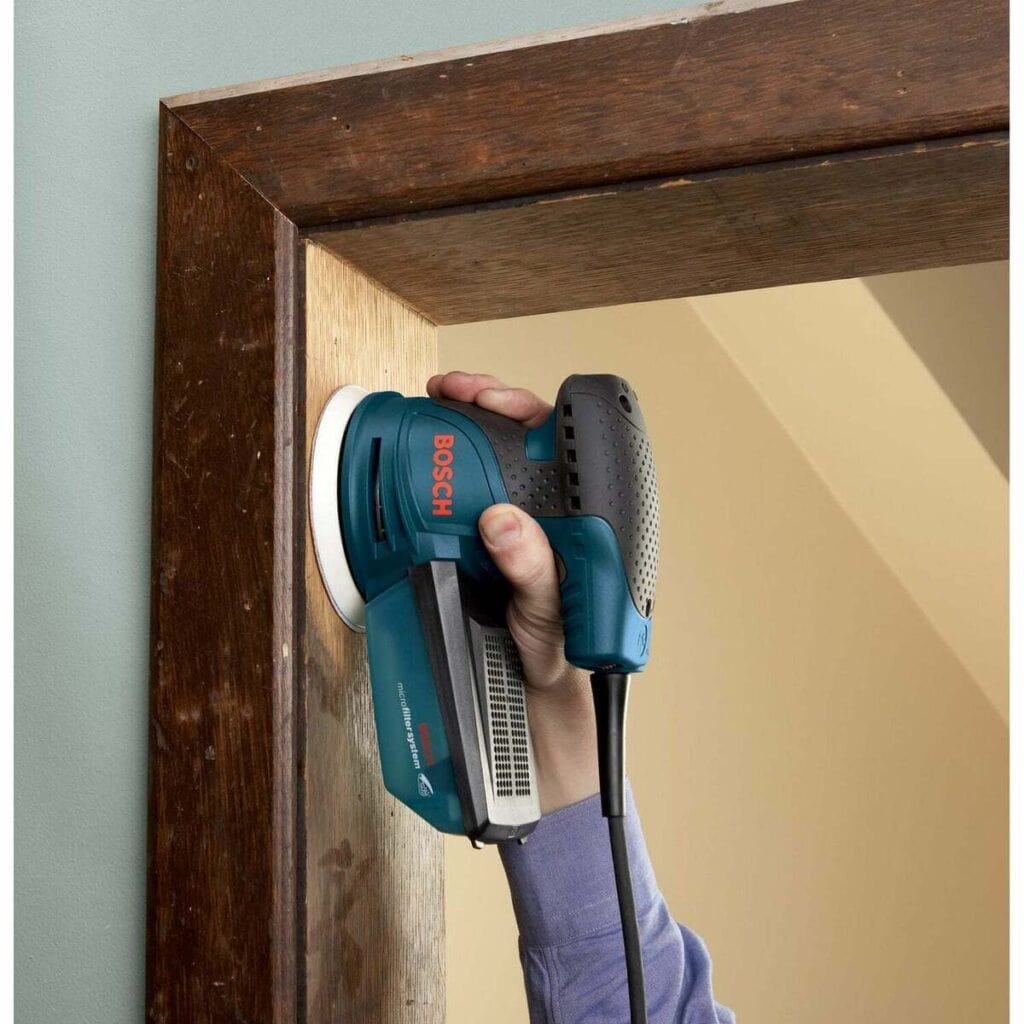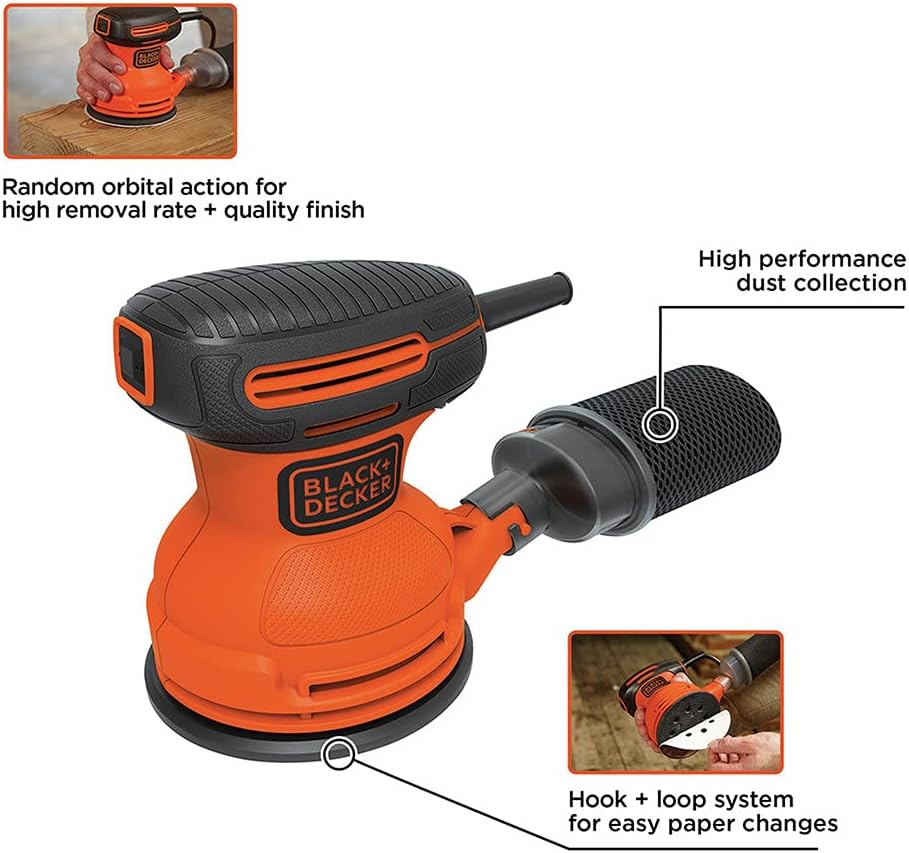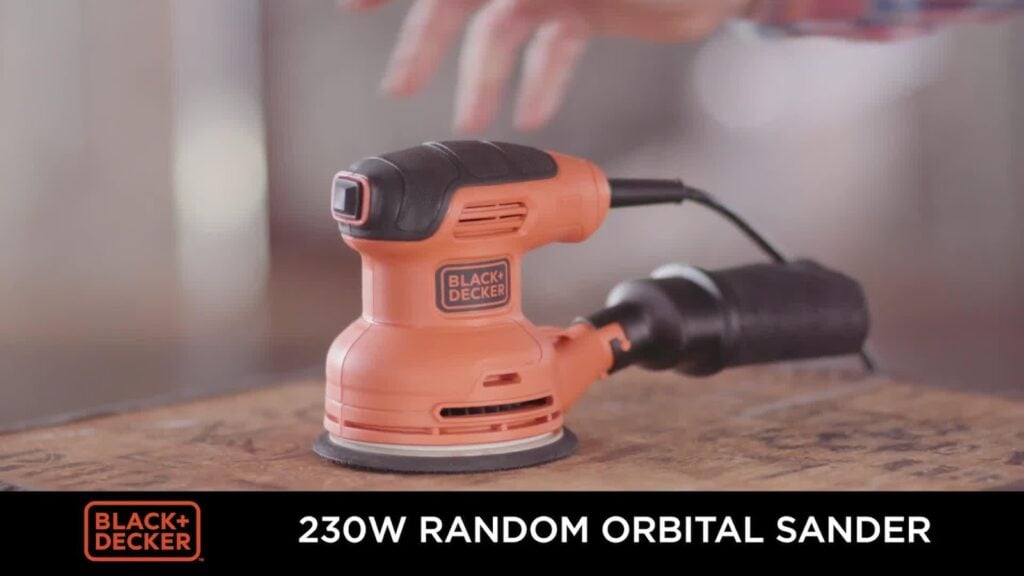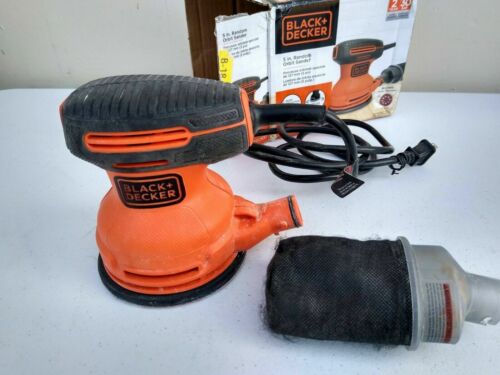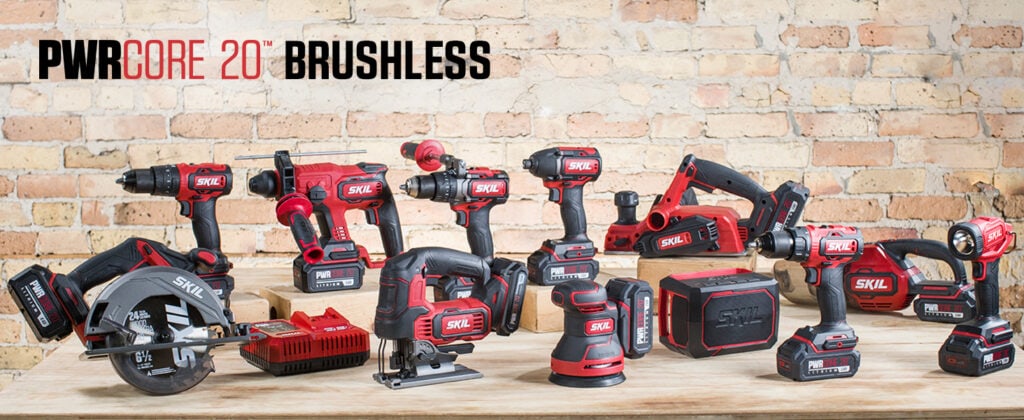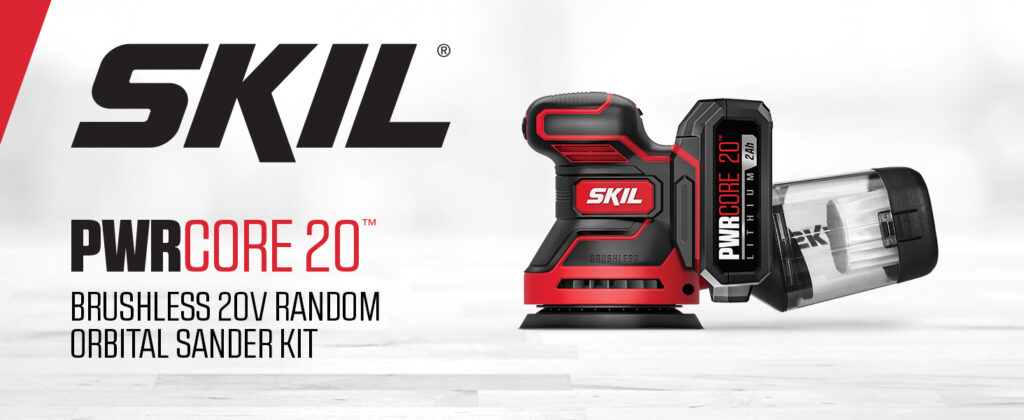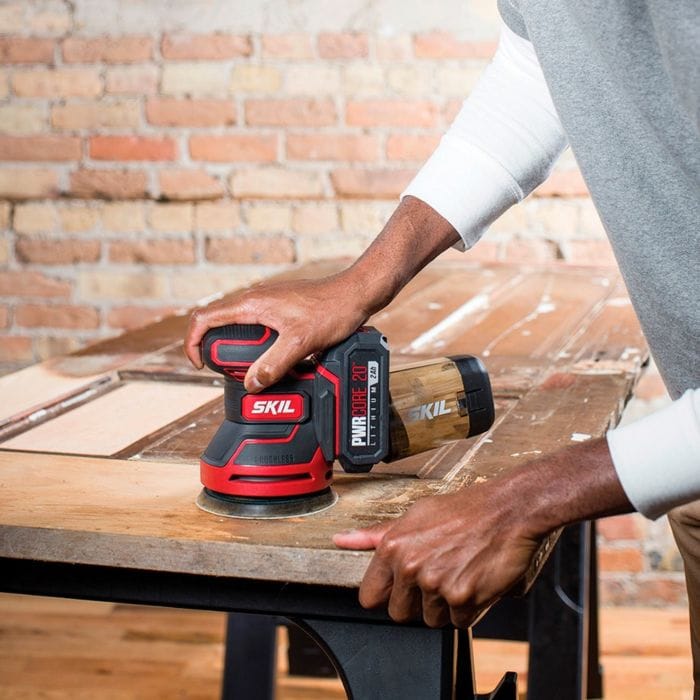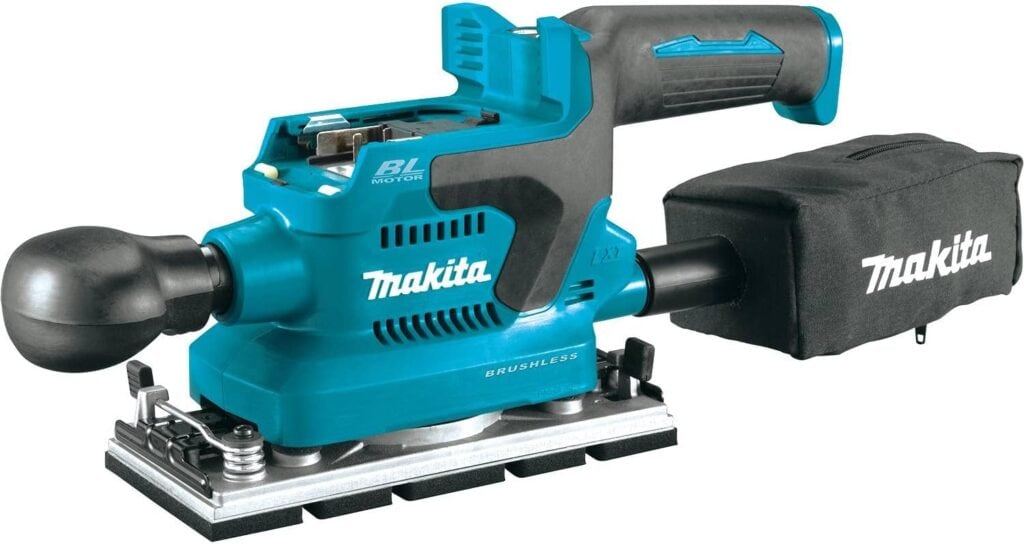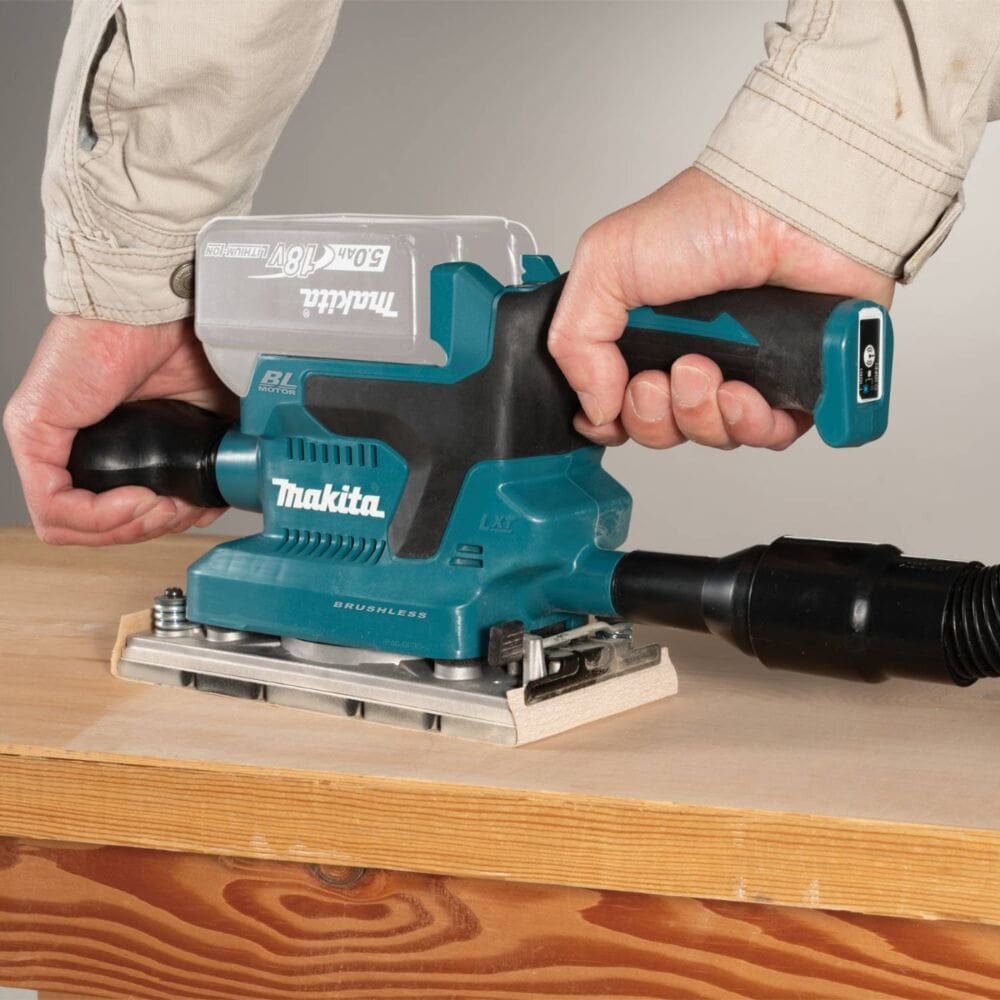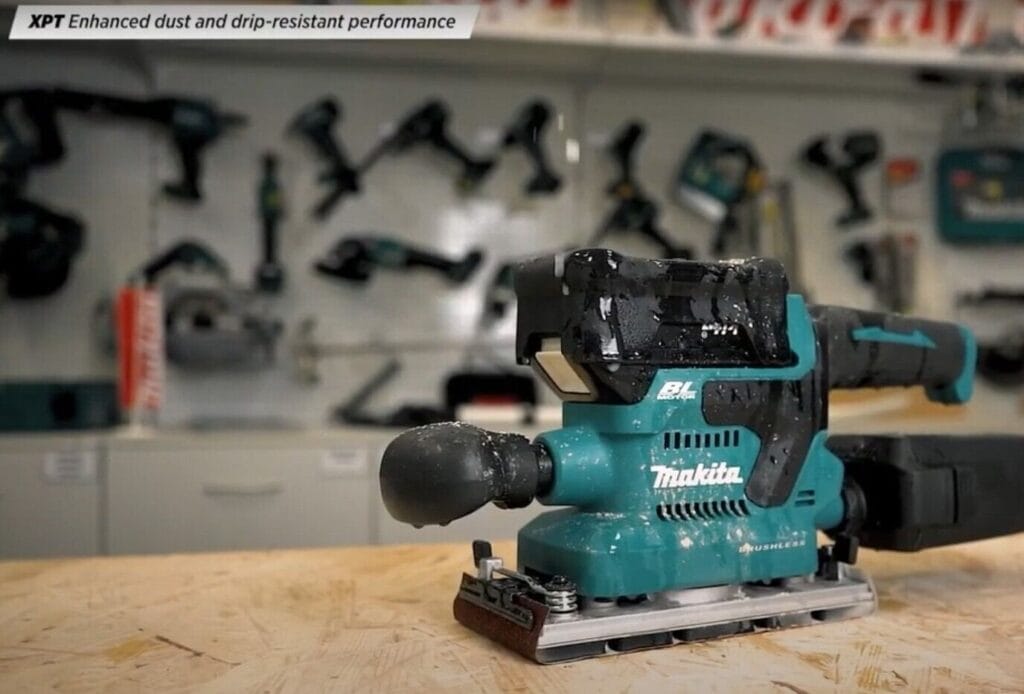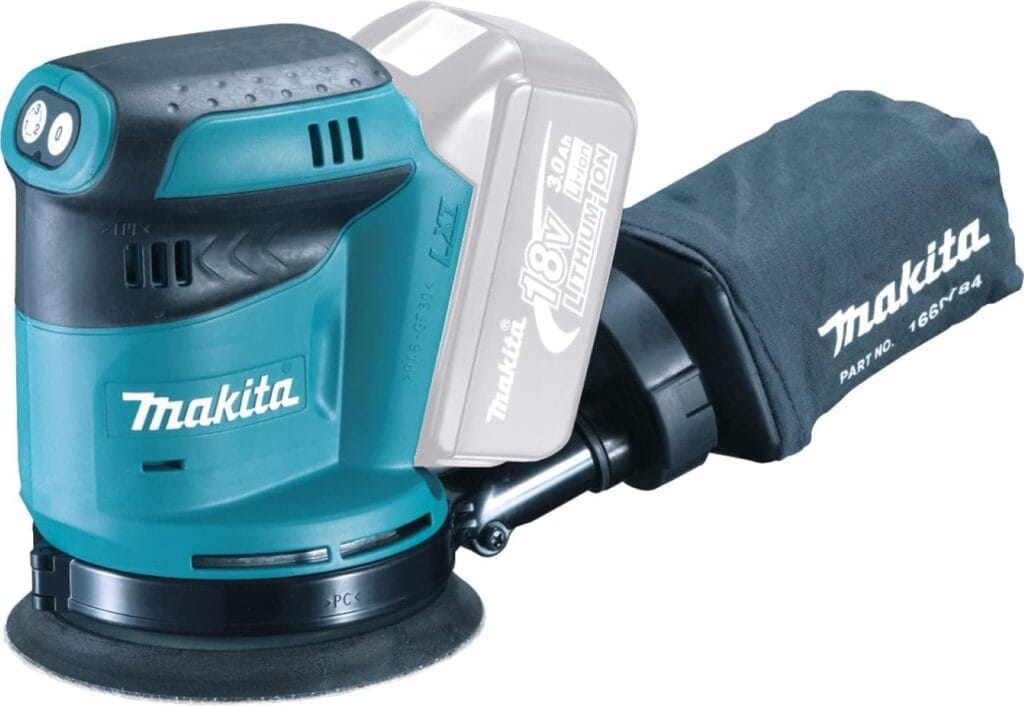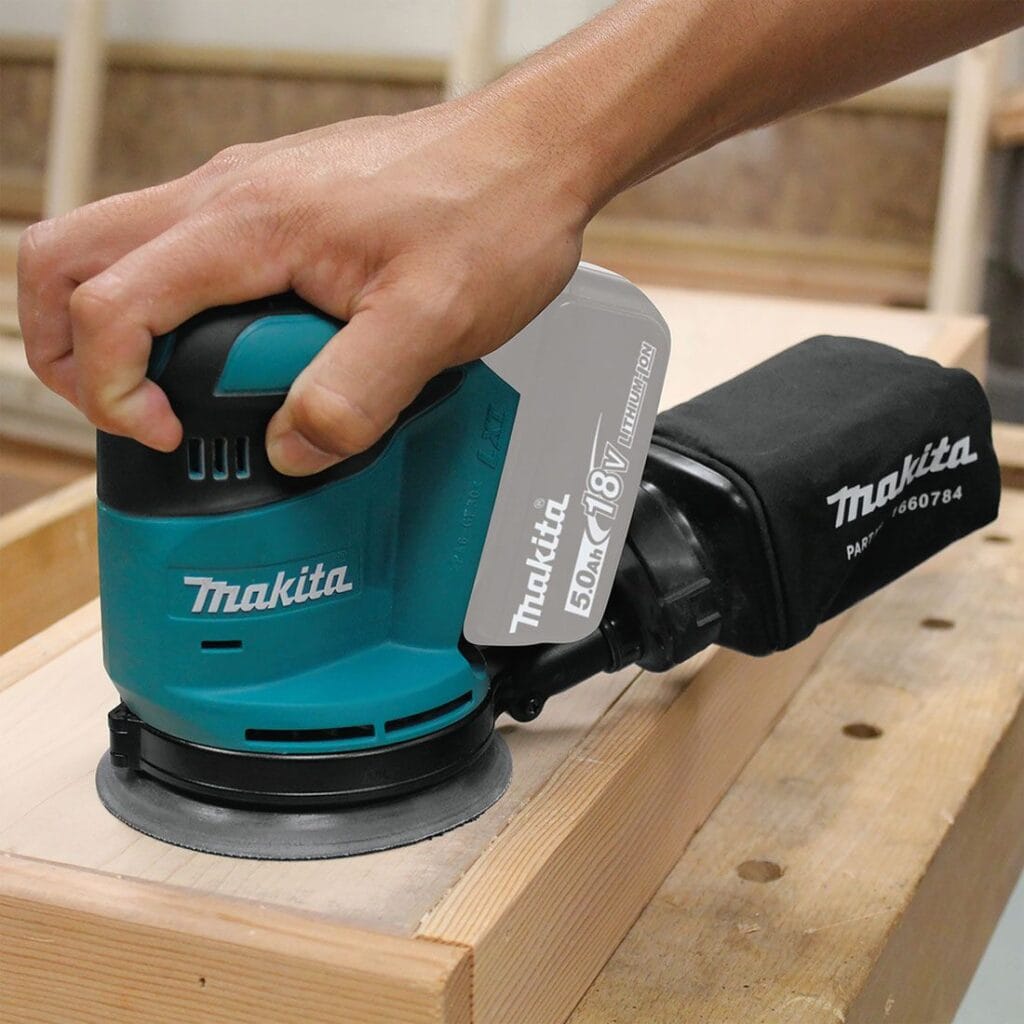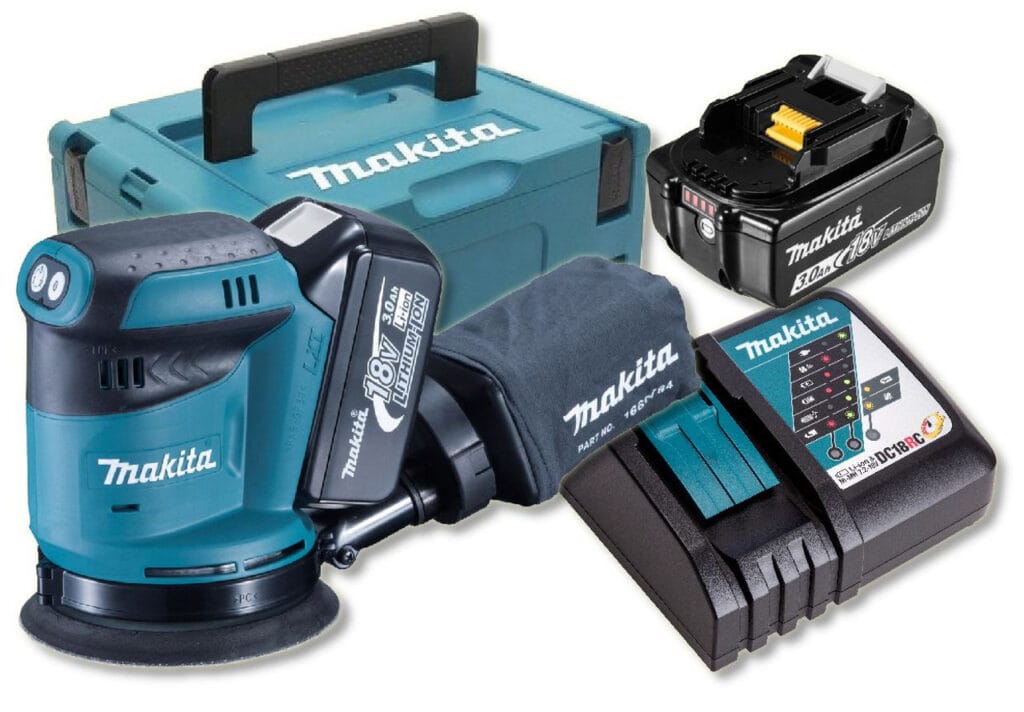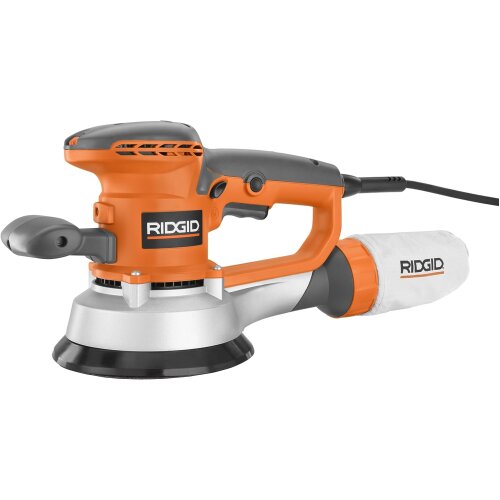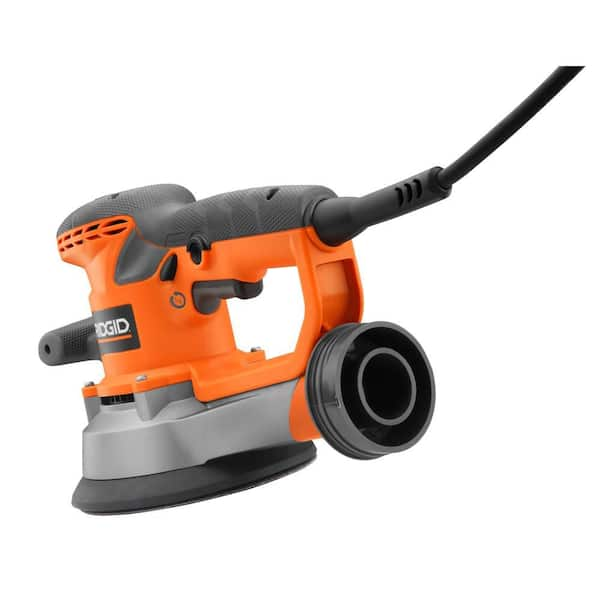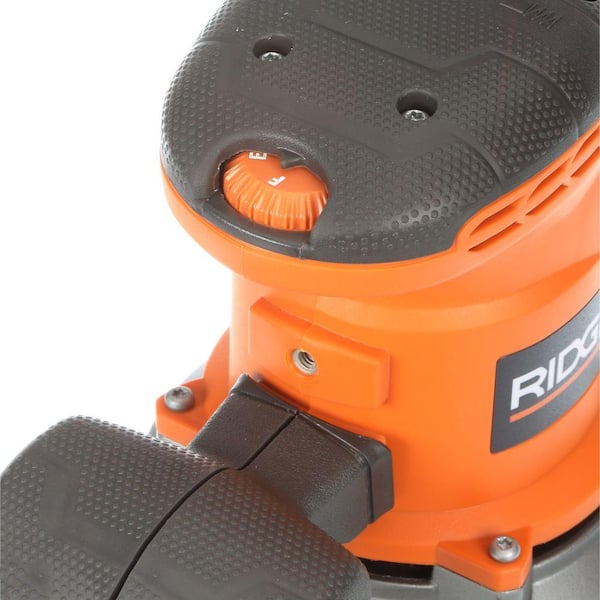In 2024, finding the best random orbital sander is key to professional-grade woodworking and DIY projects. Advancements in technology and design have led to a range of options, each boasting unique features like improved dust collection, enhanced comfort, and variable speeds. Understanding these features is essential in selecting a sander that meets your specific needs, whether for intricate furniture making or general home maintenance.
Table of contents
- Orbital Sander Features to Improve Your Work
- Random Orbital Sander vs Orbital Sanders
- Corded Sander vs Cordless Sander
- Understanding Power Sources for Orbital Sanders
- Best Orbital Sanders Reviewed
- DEWALT 20V MAX Cordless Random Orbit Sander Kit
- BOSCH ROS20VSC Palm Sander
- BLACK+DECKER Orbital Sander
- SKIL PWRCore 20 Brushless 20V Random Orbital Sander
- Makita XOB03Z 18V LXT Lithium-Ion Brushless Cordless 1/3 Sheet Finishing Sander
- Makita DBO180Z Cordless 18V Li-ion Random Orbit Sander
- Ridgid R2611 Sander, 6-Inch VS Random Orbit Sander
- FAQ
Random Orbital Sander vs Sheet Sander
Orbital Sander Features to Improve Your Work
Orbital sanders, especially the random orbital variety, have revolutionized sanding tasks with their efficiency and effectiveness. Key features such as dust collection, sanding disc design, and variable speed control have elevated these power tools, making them indispensable for both professionals and hobbyists.
Dust Collection
A crucial aspect of any sanding job is managing the dust produced. Most random orbital sanders are equipped with a dust collection system, such as a dust bag or a dust collection box, to maintain a clean workspace and minimize airborne particles. Features like vacuum hose compatibility and well-designed dust ports enhance the effectiveness of these systems, ensuring a healthier and cleaner work environment.
The starting point for dust management is the connection between the sanding pad and sanding discs. Many random orbital sander models have holes in the pad where sanding dust particles go through the tool and into the dust collector. Aligning these holes is a requirement for excellent dust collection.
Sanding Disc
The sanding disc is at the heart of an orbital sander’s functionality. Various grits cater to different sanding needs, from light touch-ups to more aggressive material removal. The best sanders allow for quick and easy sanding disc changes, and durable sanding pads ensure consistent performance over time.
Here’s a short bullet list of the five most common sanding disc grades and their typical uses:
- 60 Grit: Ideal for heavy material removal, shaping, and roughing out workpieces. It’s often used at the start of a sanding process to quickly remove material.
- 100 Grit: Best suited for moderate stripping and surface leveling. It strikes a balance between aggressive material removal and surface preparation.
- 150 Grit: Commonly used for general sanding tasks, including smoothing wood surfaces and preparing for finishing.
- 220 Grit: Ideal for final smoothing before applying a finish. It’s fine enough to create a smooth surface without significant material removal.
- 320 Grit: Used for finishing touches and fine sanding. Perfect for achieving a very smooth finish on wood and for sanding between coats of paint or varnish.
Each grade plays a unique role in the sanding process, allowing for progressive refinement from rough shaping to fine finishing.
Variable Speed Control
Variable speed control in sanders offers versatility and precision. Adjustable speeds cater to different materials and types of sanding tasks, from fine sanding that requires a delicate touch to more intensive operations where higher speeds are beneficial. This feature significantly enhances the tool’s usability across various applications.
Random Orbital Sander vs Orbital Sanders
The choice between a random orbital sander and a standard orbital sander often depends on the specific requirements of the task at hand. Random orbital sanders spin and move backward and forward at the same time. This means they are ideal for minimizing swirl marks and achieving a more uniform finish. In contrast, standard orbital sanders, which move in a simple back-and-forth motion, are often preferred for simpler, straight-line sanding tasks. They are cheaper than other sanders.
Four sander types explained
There are four different types of sanders people use. They have different purposes, but can overlap.
- Belt sander – These beasts use a continuous belt to remove a lot of wood very fast. They are great for sanding large areas, like flooring or a tabletop. But they need careful attention because they can run away from an inexperienced user and damage the workpiece.
- Disc sander – A traditional disc sander is also a very powerful sander and usually has two hand grips. They are commonly used for sanding large areas, but can be used for finer finish sanding as well.
- Random orbital sander – The workhorses of the sanding world. A random orbital sander can, in a pinch, do every sanding task you have. Their sanding speed isn’t as fast as a belt sander for super aggressive sanding, but they have a huge amount of control and great dust collection.
- Finish sanders – A true finish sander features a square or rectangular pad that uses clips to hold a 1/4, 1/2, or 1/3 sheet of sanding paper. These are ideal for achieving the best finish on a wood surface because of the control you have with them.
Corded Sander vs Cordless Sander
When deciding between a corded and a cordless sander, several factors come into play. Corded models, often more powerful, provide consistent performance without the worry of battery life. They are ideal for prolonged use in workshops where mobility is not a primary concern. On the other hand, cordless sanders offer unparalleled mobility and convenience, especially in spaces where accessing a power outlet is challenging. However, their reliance on battery power can be a limitation for extended use. The choice between corded and cordless models ultimately hinges on the specific requirements of the project and the user’s working environment.
Understanding Power Sources for Orbital Sanders
The power source of an orbital sander is a key factor that affects its performance, usability, and application. Each type – corded, cordless, and pneumatic – has its advantages and ideal use cases, catering to a wide range of sanding needs.
Corded Sanders
Corded random orbital sanders are probably the most common tools in this space. While managing a cord can be a pain, most woodworkers prefer these because of the consistent power. Also, a dust collection bag is usually terrible for gathering dust, so some kind of powered dust collection system is a big bonus. Since the dust collection system will use power, it’s likely you can find a cord nearby to plug in the sander, too.
- Consistent Power Supply: Corded sanders offer a constant power supply, ensuring sustained performance during extended use.
- Higher Power Output: Generally, corded sanders provide more power, making them suitable for heavy-duty sanding tasks and continuous workshop use.
- Dependence on Power Outlets: Their major limitation is the need for a nearby power outlet, which can restrict mobility and convenience.
Cordless Sanders
A cordless random orbit sander is super flexible because it goes anywhere. Just strap on your dust mask and you can sand wherever your work is. These are great for sanding wood in outdoor work spaces where dust collection isn’t so critical. They can also be useful for working in tight spaces where a cable is going to be even more annoying.
- Enhanced Portability: The absence of cords enhances mobility, allowing users to work in areas without immediate access to power outlets.
- Battery Dependency: Cordless sanders rely on battery life, which can limit their use in prolonged sanding tasks and requires regular recharging or spare batteries.
- Versatility: Ideal for quick, on-the-go tasks, and in situations where cord management is a concern, such as in intricate or outdoor projects.
Pneumatic Sanders
If you’re in a shop with compressed air available, you can use a powerful random orbital sander connected to an air hose. These models are usually lighter and quieter. But you have to have an air hose and air compressor. This makes them even less flexible than a standard corded random orbital sander.
- Powered by Compressed Air: Pneumatic sanders require an air compressor, making them distinct from electric models.
- Lightweight and Powerful: These sanders are often lighter than their electric counterparts and can offer considerable power, suitable for professional-grade tasks.
- Requirement of Air Compressor: The need for a compressor can be a drawback, as it adds to the overall investment and requires maintenance. However, it’s an excellent choice for high-precision work in professional settings.
Each power source caters to different needs and environments. Corded sanders are preferred for consistent, heavy-duty work, cordless for flexibility and convenience, and pneumatic for professional, high-precision tasks. Understanding these differences is crucial in selecting the most suitable orbital sander for your specific projects.
Best Orbital Sanders Reviewed
Our team of craftspeople at Artisan Born use power tools and hand tools every day. With a few men and women in the shop, tools get passed around and evaluated by a bunch of different people.
Are there affiliate links in this article? Yes.
But these reviews come from people who know their stuff, build furniture and projects every day, and have thousands of hours behind tools of all kinds.
DEWALT 20V MAX Cordless Random Orbit Sander Kit
The DEWALT 20V MAX Random Orbit Sander Kit is a game-changer in the world of power sanders. Renowned for its cordless convenience and impressive power, this sander stands out for its ability to handle a variety of sanding tasks with ease.
Detailed Product Description
This sander’s design is robust, featuring a brushless motor and a 5-inch sanding pad. It’s powered by a 20V battery, offering the freedom of cordless operation. Key features include variable-speed control ranging from 8,000 to 12,000 OPM, a low-profile height for precise sanding, and a replaceable 8-hole hook-and-loop sanding pad for easy paper changes. Additionally, it boasts a dust-sealed switch and a texturized rubber grip for comfort.
Personal Experience and Usage
We found the DEWALT 20V MAX Sander to be highly efficient and user-friendly. It’s suitable for both heavy-duty and fine finish sanding, with variable speed allowing for optimal control. The cordless design provides excellent mobility, especially in tight spaces, and the ergonomic handle reduces fatigue during extended use.
Pros and Cons: Pros:
- Cordless design enhances mobility.
- Variable speed control for versatility.
- Ergonomic and comfortable to use.
- Efficient dust collection system.
Cons:
- Not ideal for very large projects.
- Battery life may vary depending on usage intensity.
Comparative Analysis
Compared to other models like the Bosch ROS20VSC Palm Sander, the DEWALT sander offers superior mobility thanks to its cordless design. However, in terms of battery life, corded models might have an edge for prolonged use.
Customer Feedback and Ratings
Customers rate the DEWALT Sander highly, with an average rating of 4.8 out of 5. Many praise its ease of use, maneuverability, and value for money. Some reviews mention the convenience of the cordless design and the efficient dust collection system.
Price and Availability
The DEWALT 20V MAX Random Orbit Sander Kit is priced at $129.00 on Amazon, marked down from $249.00. It’s readily available for purchase with options for free returns and additional protection plans.
The DEWALT 20V MAX Random Orbit Sander Kit is an excellent choice for both professional and DIY users seeking a powerful, versatile, and portable sanding tool. It’s particularly recommended for those who value ease of use and efficiency in their work.
BOSCH ROS20VSC Palm Sander
The BOSCH ROS20VSC Palm Sander is a standout power tool for anyone involved in woodworking or detailed sanding tasks. This corded, variable-speed orbital sander/polisher kit is known for its ability to deliver smooth finishes without the hassle of dust.
Detailed Product Description
Sporting a compact and ergonomic design, this sander features a powerful 2.5 AMP motor, suitable for various sanding tasks. Its dimensions are 9″L x 5″W x 6″H with a fine grit type. The sander comes with a pad dampening system to prevent swirl marks, a Hook and Loop disc attachment for easy sandpaper changes, and a microfilter dust collection system. With a voltage of 120 Volts, it is a corded electric tool, offering a no-load OPM range of 7,500-12,000.
Personal Experience and Usage
In my use, the BOSCH ROS20VSC has proven to be an efficient and reliable sander. It’s particularly good for fine finishes on both flat and contoured surfaces. The variable speed control is helpful for adjusting to different tasks, and the dust collection system is notably efficient, keeping the workspace clean.
Pros and Cons
Pros:
- Ergonomic design for comfortable use.
- Effective dust collection system.
- Variable speed for task versatility.
- Durable and reliable performance.
Cons:
- Corded design limits mobility.
- Dust canister may require frequent emptying.
Comparative Analysis
It’s hard to beat this simple Bosch sander. For the price, it’s one of the best random orbital sanders you can buy. The only niggle is the dust port. You can buy a dust port adapter to connect a vacuum hose and collect dust effectively. But the connection isn’t very strong. It’s nothing some duct tape won’t fix, but it could be better out of the box.
Customer Feedback and Ratings
With a 4.6 out of 5 stars rating on Amazon, customers generally praise its ease of use, ergonomic design, and effective dust collection. Users have noted its durability and suitability for various sanding tasks.
Price and Availability
Priced at $50.15 on Amazon, it’s a competitively priced option in the power sanding market. Various buying options, including protection plans, are available.
The BOSCH ROS20VSC Palm Sander is a great choice for both DIY enthusiasts and professionals seeking a reliable and efficient sander. It’s best suited for those who prioritize smooth finishes and efficient dust management in their work.
BLACK+DECKER Orbital Sander
The BLACK+DECKER Orbital Sander, model BDERO100, is a popular choice for DIY enthusiasts and professionals alike. Known for its high performance and affordability, this 5-inch, 2.0 Amp, 12000 OPM sander offers a swirl-free finish with a user-friendly design.
Detailed Product Description
This orbital sander boasts a compact design measuring 7″L x 5″W x 6″H, making it suitable for tight spaces. The fine grit type ensures a smooth finish, and its 120-volt corded electric power source delivers consistent performance. Key features include a built-in dust collection system, a comfort grip handle for reduced fatigue, and a hook-and-loop system for quick and easy sandpaper changes.
Personal Experience and Usage
In our experience, the BLACK+DECKER Orbital Sander is a reliable tool for a range of sanding tasks. Its lightweight design and ergonomic handle make it easy to use for extended periods, while the dust bag efficiently collects debris, keeping the workspace clean.
Pros and Cons
Pros:
- Compact and lightweight, ideal for extended use.
- Efficient dust collection system.
- Easy sandpaper changes with the hook-and-loop system.
- Great value for money.
Cons:
- Corded design may limit mobility.
- Limited to one speed setting.
Comparative Analysis
Compared to models like the BOSCH ROS20VSC, the BLACK+DECKER BDERO100 lacks variable speed control but excels in affordability and is equally efficient in basic sanding tasks.
Customer Feedback and Ratings
The product has garnered positive reviews, scoring 4.6 out of 5 stars on Amazon. Customers praise its ease of use, ergonomic design, and effective dust collection. Many find it an excellent choice for small to medium projects.
Price and Availability
Priced at $31.65 on Amazon, the BLACK+DECKER Orbital Sander is an affordable option in the power tool market. Protection plans are available for an additional fee.
The BLACK+DECKER Orbital Sander (BDERO100) is a great choice for those seeking an efficient, affordable, and user-friendly sanding tool. It’s particularly suitable for DIY enthusiasts and hobbyists.
SKIL PWRCore 20 Brushless 20V Random Orbital Sander
The SKIL PWRCore 20 Brushless 20V 5-Inch Random Orbital Sander, model SR660302, marks a significant advancement in the realm of power sanding tools. Its cordless design powered by a robust lithium battery makes it a standout choice for both professional and DIY projects.
Detailed Product Description
This SKIL orbital sander features a brushless motor, offering efficient and high-performance power with up to 11,000 RPM. It’s equipped with a medium grit type and a versatile hook and loop pad for easy sandpaper changes. The package includes a 2.0Ah lithium battery with a PWRJump charger, capable of fast charging in just 5 minutes. The sander also boasts variable speed control, a microfiltration dust canister, and a dust-sealed switch for extended tool life.
Personal Experience and Usage
For our teams, the SKIL PWRCore 20 sander has proven exceptionally effective for various sanding tasks. Its cordless nature provides excellent mobility, and the variable speed control allows for precision work on different materials. The battery life is impressive, and the quick charge feature is a significant convenience. It doesn’t have the best dust collection and the dust collection port can blow dust back into your face if you’re on the wrong side.
Pros and Cons
Pros:
- Cordless design for enhanced mobility.
- Quick charging with PWRJump technology.
- Variable speed for versatile sanding.
- Efficient dust collection system.
Cons:
- Slightly heavier due to the battery.
- Battery life may vary based on usage intensity.
Comparative Analysis
Compared to traditional corded sanders like the Bosch ROS20VSC, the SKIL PWRCore 20 offers the advantage of cordless operation, though it might be slightly heavier due to the battery. The fast charging feature is a unique benefit not commonly found in other models.
Customer Feedback and Ratings
The sander has received a favorable rating of 4.6 out of 5 stars on Amazon. Customers appreciate its power, battery life, and the convenience of cordless operation. Some have noted the dust collector’s effectiveness and the overall quality build.
Price and Availability
Priced at $102.88 on Amazon, this SKIL sander is positioned as a mid-range option in the cordless sander market. Protection plans are available for additional purchase.
The SKIL PWRCore 20 Brushless 20V Random Orbital Sander is an excellent investment for those seeking a powerful, versatile, and convenient sanding tool. It’s particularly well-suited for users who frequently move around or work in areas without easy access to power outlets.
Makita XOB03Z 18V LXT Lithium-Ion Brushless Cordless 1/3 Sheet Finishing Sander
The Makita XOB03Z 18V LXT Lithium-Ion Brushless Cordless 1/3 Sheet Finishing Sander stands out in the power tool market. As a part of Makita’s reputable 18V LXT lineup, this sander promises both the freedom of cordless operation and the precision of a high-quality finishing tool.
Detailed Product Description
This Makita model is a battery-powered sander, making it highly portable for a variety of work environments. It offers three-speed settings (4,000/8,000/12,000 OPM), allowing users to adjust according to the task at hand. The 1/16″ orbit action is engineered for faster sanding and a swirl-free finish. The ergonomically designed body enhances user comfort, and the placement of the motor and battery helps reduce flutter, ensuring an evenly finished surface.
One of the cool features is the auto wireless start for connected dust collection devices. This handy features turns the dust extractor on and off as needed, saving you one step and some unnecessary noise.
Personal Experience and Usage
For the team members in our shop, the Makita XOB03Z sander has proven to be a reliable and efficient tool. Its cordless nature allows for easy maneuverability, and the variable speed settings are particularly useful for different types of finishing work. The tool’s design makes it comfortable to hold and use, even for extended periods. It’s ideal for finish work and makes achieving a beautiful finish easier than many of our regular palm sanders.
Pros and Cons
Pros:
- Cordless design offers excellent mobility.
- Three-speed settings for versatile sanding.
- Ergonomic design for user comfort.
- Effective for achieving a swirl-free finish.
Cons:
- Battery life may vary with intensity of use.
- Higher price point compared to some corded models.
Comparative Analysis
When compared to corded sanders like the Bosch ROS20VSC, the Makita XOB03Z offers the advantage of portability. However, it might be more expensive upfront, especially when considering the cost of batteries and a charger.
Customer Feedback and Ratings
The Makita XOB03Z has received high praise from users, with a rating of 4.8 out of 5 stars on Amazon. Customers appreciate its power, ease of use, and the quality of finish it provides.
Price and Availability
Priced at $174.94 on Amazon, it is positioned as a premium tool in its category. It is available for purchase with the option of additional protection plans.
The Makita XOB03Z is a top-tier choice for professionals and serious DIY enthusiasts who need a portable yet powerful finishing sander. It is especially recommended for those already invested in the Makita 18V LXT battery platform.
Makita DBO180Z Cordless 18V Li-ion Random Orbit Sander
The Makita DBO180Z, a cordless 18V Li-ion Random Orbit Sander, is a great choice for a cordless sander. If you’re already the owner of the Makita battery system, then the Makita random orbital sander is a logical choice over most other random orbit sanders.
Detailed Product Description
Designed for efficiency, the Makita DBO180Z features a compact and ergonomic build, ideal for various sanding tasks that require mobility. Operating on an 18V Li-ion battery, it delivers consistent power without the constraint of cords. The sander has a 125 mm sanding base, suitable for a range of materials, and a grit number of 100 for medium-level abrasiveness. It weighs 1.3 kilograms, making it lightweight and easy to handle for extended periods.
Personal Experience and Usage
The Makita DBO180Z has proven to be a reliable and convenient tool. Its cordless design allows for ease of movement, especially in tight spaces or when working on ladders. The battery life is commendable, providing ample time for most sanding tasks before needing a recharge. Like all Makita tools, this is a well-built bit of kit that managed our tasks with ease.
Pros and Cons
Pros:
- Cordless convenience enhances mobility.
- Lightweight and ergonomic design.
- Efficient sanding with a good quality finish.
- Easy to operate and change sandpaper.
Cons:
- Battery and charger are sold separately.
- May not be as powerful as some corded models.
Comparative Analysis
Compared to a corded tool, the Makita DBO180Z offers unmatched mobility. However, it might require additional investment in batteries and chargers, unlike models that come with an all-inclusive package. You are buying into the Makita brand and battery ecosystem, which could be a great choice because of its quality.
Customer Feedback and Ratings
The Makita DBO180Z has received positive feedback, with a 4.7 out of 5 stars rating on Amazon. Users often praise its ease of use, effective sanding capability, and the convenience of being cordless.
Price and Availability
Priced at $136.00 on Amazon, the Makita DBO180Z is competitively positioned in the cordless sander market. It’s available for purchase, with options for protection plans and compatible accessories.
The Makita DBO180Z is an excellent choice for those seeking a cordless, easy-to-use, and efficient sander. It is ideally suited for users who prioritize mobility and are already invested in Makita’s battery ecosystem.
Ridgid R2611 Sander, 6-Inch VS Random Orbit Sander
The Ridgid R2611 Sander is a great option in the power tools segment, especially for those seeking a 6-Inch Variable Speed Random Orbit Sander. This model is designed to cater to both DIY enthusiasts and professional craftsmen, offering a blend of power, precision, and versatility. Its best feature is probably the ability to switch between random orbit and a normal orbital sander mode. This makes it more suitable for dual use as a finish sander.
Detailed Product Description:
Ridgid’s R2611 Sander is engineered with a dual random orbit setting, allowing users to switch between fine finishing and aggressive material removal. It boasts an electronic speed control ranging from 4,000 to 10,000 RPM, adaptable to various project needs. The sander also features a soft start and integrated pad brake control, ensuring a gouge-free finish on workpieces. Its microfiber hook and loop pad enhances sanding efficiency, while the onboard vacuum adaptor is compatible with 1-1/4 in. and 2-1/4 in. vacuum hoses, aiding in dust management.
Personal Experience and Usage:
During my use of the Ridgid R2611, I found it exceptionally powerful for a range of sanding tasks. Its variable speed settings are particularly useful for different surfaces and materials. The sander feels robust and well-built, providing a sense of reliability and longevity.
Pros and Cons
Pros:
- Versatile with dual orbit settings for various applications.
- Variable speed control for precision work.
- Efficient dust collection system.
- Comfortable and ergonomic design for prolonged use.
Cons:
- Slightly heavier compared to some competitors.
- The dust collection bag could be more effective.
Comparative Analysis
When compared to other sanders like the DEWALT DWE6423, the Ridgid R2611 stands out for its higher power and speed variability. However, it may fall slightly short in terms of weight and portability.
Customer Feedback and Ratings
The Ridgid R2611 has garnered a 4.1 out of 5 stars rating on Amazon, indicating a generally positive reception. Customers praise its robust performance and versatility, though some have noted its weight and dust bag efficiency as minor drawbacks.
Price and Availability
Priced at $115.00 on Amazon, the Ridgid random orbital sander offers good value for its features and performance. It is readily available for purchase, with options for protection plans and various shipping choices.
The Ridgid R2611 is a solid choice for those needing a versatile and powerful random orbit sander. It is best suited for users who prioritize performance over portability and are engaged in diverse sanding tasks.
FAQ
What is the best orbital sander to buy?
If you can only buy one tool, the best orbital sander is probably the RIDGID R2611 because of its dual orbit option. This makes it more versatile than a standard random orbital sander.
What is the best orbital sander for dust control?
Almost all sanders come with a dust collection bag, but the best ones have a dust port that can be connected to your shop vac. This greatly increases dust collection capabilities and removes a lot of fine dust from the air. So, choose a sander that can connect to your shop vacuum for the best dust collection.
Why buy a random orbital sander?
A random orbital sander will do two things for you:
- Save you a lot of time compared to hand sanding. Even for light sanding tasks, random orbital sanders are much faster than working by hand.
- The best random orbital sanders will give you a superior finish, maybe even better than you can achieve by hand. This is especially true if you are working on a large project.
What is the most aggressive type of sander?
A belt sander is the most aggressive sander you can use. These powerful tools can hog off lots of wood very quickly, which makes them ideal for some projects, such as finishing a large flat surface like a tabletop or floor.

